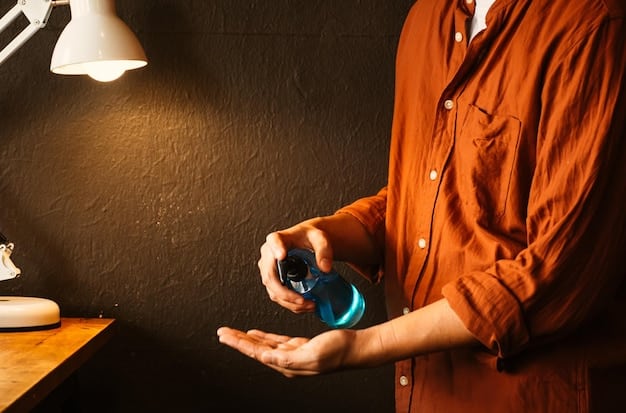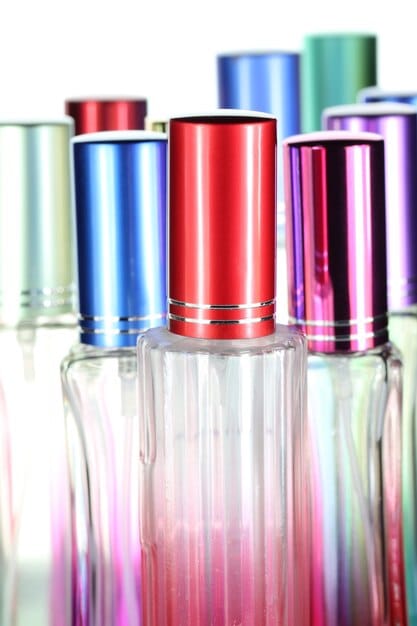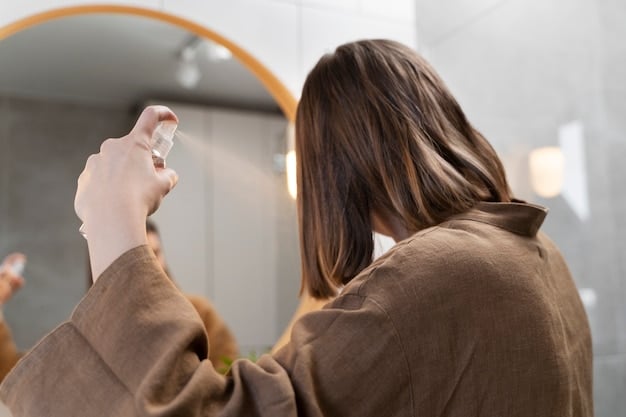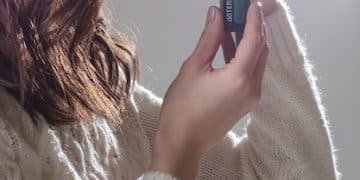The Art of Perfume Application: Maximize Sillage and Projection

The art of perfume application involves strategic placement and techniques to maximize its sillage (the trail it leaves) and projection (its reach), ensuring a lasting and impactful fragrance experience.
Unlocking the full potential of your favorite fragrance isn’t just about the scent itself; it’s about how you wear it. The art of perfume application: maximizing sillage and projection involves understanding how to make your perfume last longer and leave a memorable impression.
Understanding Sillage and Projection
Before delving into application techniques, it’s important to understand the concepts of sillage and projection. These two terms describe how a fragrance interacts with the space around you and how others perceive it.
What is Sillage?
Sillage, derived from the French word for “wake,” refers to the trail of scent left behind by a person wearing perfume. It’s the lingering aroma that others notice even after you’ve passed by.
What is Projection?
Projection, on the other hand, is the perfume’s ability to radiate outwards from the wearer. It’s how far the fragrance travels and how strongly it can be detected at a distance.

Several factors influence a perfume’s sillage and projection, including the concentration of the fragrance, the specific notes used, and, crucially, how it’s applied.
Choosing the Right Perfume
The concentration of a perfume plays a significant role in its sillage and projection. Perfumes are typically categorized into several concentrations, each with varying levels of fragrance oil.
- Parfum: This is the highest concentration, containing 20-30% fragrance oil. Parfums are known for their long-lasting scent and potent sillage.
- Eau de Parfum (EdP): With 15-20% fragrance oil, Eau de Parfums offer a good balance between longevity and projection. They are a popular choice for everyday wear.
- Eau de Toilette (EdT): Containing 5-15% fragrance oil, Eau de Toilettes are lighter and more refreshing. They have a moderate sillage and projection.
- Eau de Cologne (EdC): This is the lowest concentration, with 2-4% fragrance oil. Eau de Colognes are typically very light and have a short lifespan.
Choosing a perfume with a higher concentration will naturally result in a stronger sillage and projection. However, it’s also important to consider the specific notes used in the fragrance. Some notes, such as amber, vanilla, and musk, tend to have a longer-lasting and more pronounced scent than others.
Consider the occasion and your personal preferences when selecting a perfume. A strong, projecting fragrance may be suitable for a night out, while a lighter scent might be more appropriate for the office.
Strategic Application Points
Where you apply your perfume can significantly impact its performance. Applying fragrance to specific pulse points, where blood vessels are close to the skin’s surface, helps to amplify the scent.
Pulse Points
Pulse points are areas on the body where the blood vessels are closest to the skin’s surface. The warmth generated in these areas helps to activate the fragrance and release its aroma more effectively.
- Wrists: Applying perfume to your wrists is a classic technique. However, avoid rubbing your wrists together, as this can break down the fragrance molecules and diminish the scent.
- Neck: Applying perfume to the sides of your neck allows the fragrance to waft upwards and surround you.
- Behind the Ears: This is another excellent pulse point, as the warmth behind the ears helps to diffuse the scent.
- Inside Elbows: Applying perfume to the inside of your elbows is a good option, especially during warmer months.
Other strategic locations include behind the knees, which helps the scent rise throughout the day, and even lightly spraying it onto your hair (from a distance) for a subtle, lingering aroma.

Application Techniques for Maximum Impact
The way you apply your perfume can also influence its sillage and projection. Experiment with different techniques to find what works best for your chosen fragrance.
Spraying vs. Dabbing
Spraying perfume allows for a more even distribution of the fragrance, while dabbing can concentrate the scent in a specific area. If you’re using a spray bottle, hold it several inches away from your skin and mist the perfume onto your pulse points. For dabbing, gently apply the fragrance to your skin without rubbing.
Layering
Layering involves using multiple products with the same or complementary scents to create a more complex and long-lasting fragrance profile. This can include using a scented body lotion, shower gel, and perfume from the same fragrance line.
By layering your fragrance, you can build a stronger base for the perfume to adhere to, extending its longevity and enhancing its sillage.
Factors Affecting Fragrance Longevity
Various factors can influence how long a fragrance lasts on your skin and how well it projects. Understanding these factors can help you optimize your perfume application.
Skin Type
Dry skin tends to absorb fragrance more quickly than oily skin. If you have dry skin, consider moisturizing before applying perfume to create a barrier that helps to hold the scent.
Environmental Conditions
Hot and humid weather can intensify a fragrance, while cold and dry weather can diminish its projection. Adjust your perfume application accordingly, using lighter scents in warmer weather and stronger scents in colder weather.
Lifestyle
Your daily activities can also impact fragrance longevity. Physical activity and sweating can cause the scent to fade more quickly. Reapplying perfume throughout the day can help to maintain its sillage and projection.
Consider reapplying every 3-4 hours to keep your perfume at its peak performance. If you have sensitive skin, avoid reapplying too frequently to prevent irritation.
Common Mistakes to Avoid
Even with the right perfume and application techniques, certain mistakes can hinder its sillage and projection. Avoiding these common errors can help you get the most out of your fragrance.
- Rubbing Wrists Together: As mentioned earlier, rubbing your wrists together after applying perfume can break down the fragrance molecules and diminish the scent.
- Applying to Dry Skin: Perfume adheres better to moisturized skin. Applying to dry skin can cause the scent to fade more quickly.
- Spraying Too Close: Holding the perfume bottle too close to your skin can create a concentrated, overpowering scent that quickly fades.
- Using Expired Perfume: Perfumes can expire over time, losing their potency and altering their scent. Check the expiration date and store your perfumes properly to prolong their shelf life.
Proper storage involves keeping your perfumes in a cool, dark place away from direct sunlight and extreme temperatures. This helps to preserve the fragrance’s integrity and longevity.
Understanding Fragrance Families
To further enhance your perfume application, understanding fragrance families can be invaluable. Different families have distinct characteristics that affect sillage and projection.
Key Fragrance Families
Each fragrance family evokes different feelings and is suited for different occasions. Knowing these can help in selecting a fragrance that not only smells good but also aligns with your personal style and the setting.
- Floral: These are often light and airy, with moderate sillage. Perfect for daytime and spring.
- Oriental: Rich and warm, these tend to have strong projection and longevity, ideal for evening and winter.
- Woody: Earthy and masculine, they provide a moderate sillage and are versatile for all seasons.
- Fresh: Zesty and clean, these are subtle but refreshing, best for casual or sporty settings.
Understanding fragrance families allows you to choose scents that align with your desired impact and environment. Experimenting with different families can also expand your fragrance preferences and discover new favorites.
| Key Point | Brief Description |
|---|---|
| 📍 Strategic Placement | Apply perfume to pulse points for amplified scent release. |
| 💧 Hydrated Skin | Moisturize before applying perfume to enhance longevity. |
| 🚫 Avoid Rubbing | Do not rub wrists together, as it degrades the fragrance. |
| 🌬️ Layering Scents | Use complementary scented products to build a lasting fragrance profile. |
Frequently Asked Questions (FAQs)
To enhance perfume longevity, apply it on moisturized skin and strategic pulse points like wrists and neck. Avoid rubbing your wrists together, and consider layering with complementary scented products to build a stronger base.
Pulse points are areas with blood vessels close to the skin’s surface. Applying perfume to these areas, such as wrists and behind the ears, leverages body heat to activate and diffuse the fragrance more effectively.
Yes, skin type significantly impacts fragrance longevity. Dry skin absorbs perfume faster, causing it to fade quickly. Hydrating your skin beforehand creates a moisture barrier, helping fragrances last longer by clinging to the hydrated surface.
Spraying distributes fragrance more evenly, while dabbing concentrates it in one spot. Spraying is ideal for overall coverage and projection, whereas dabbing is suitable for those who prefer a more subtle and personal scent experience.
Climate significantly influences how perfume performs. Humid environments amplify scents, while cold, dry air diminishes them. Adjust the intensity and type of fragrance based on the weather to maximize sillage and longevity effectively.
Conclusion
Mastering the art of perfume application involves understanding sillage and projection, strategic placement, and the impact of factors like skin type and environmental conditions. By applying these techniques, you can ensure your fragrance makes a lasting impression.





